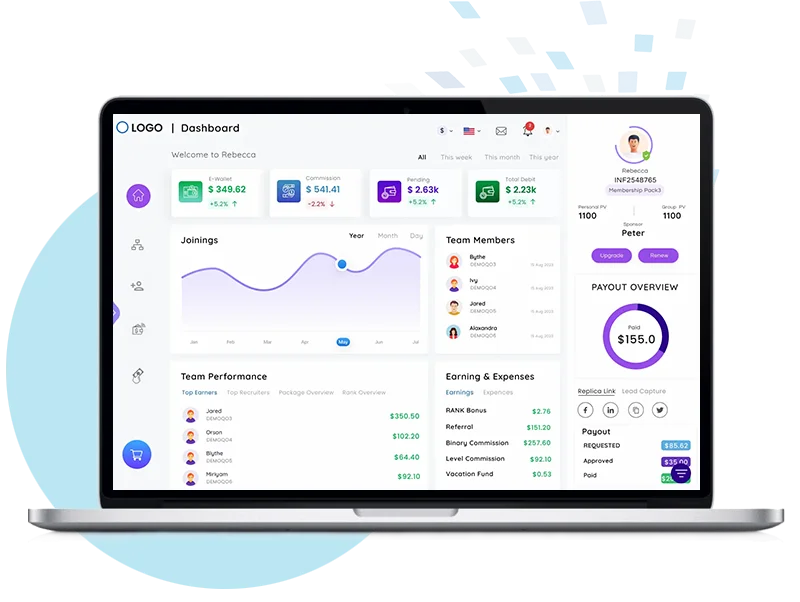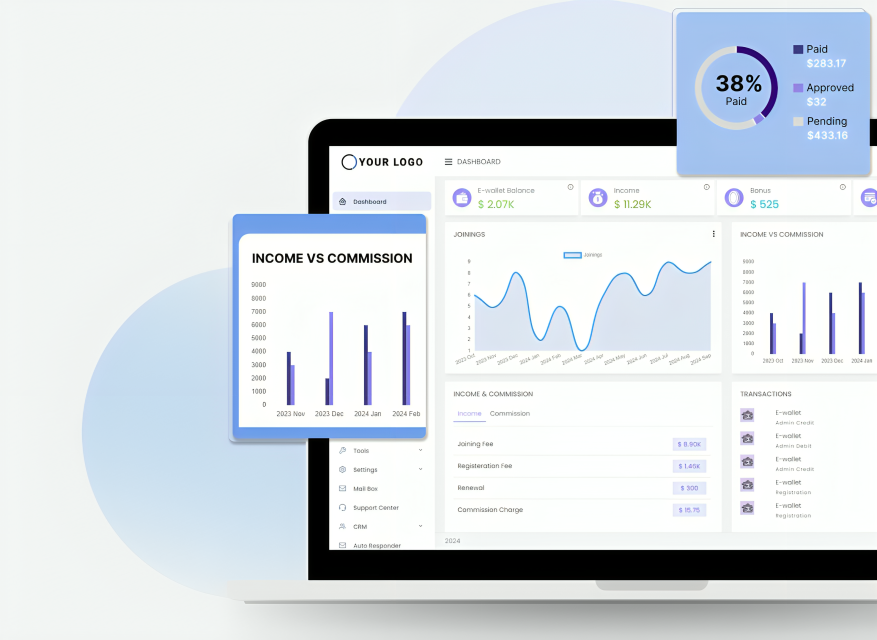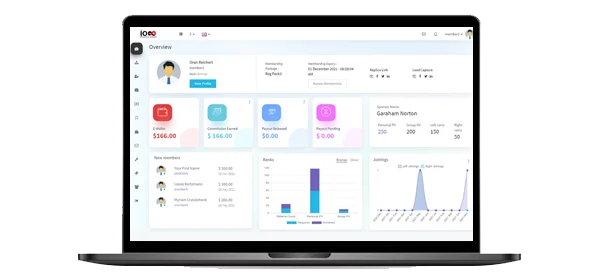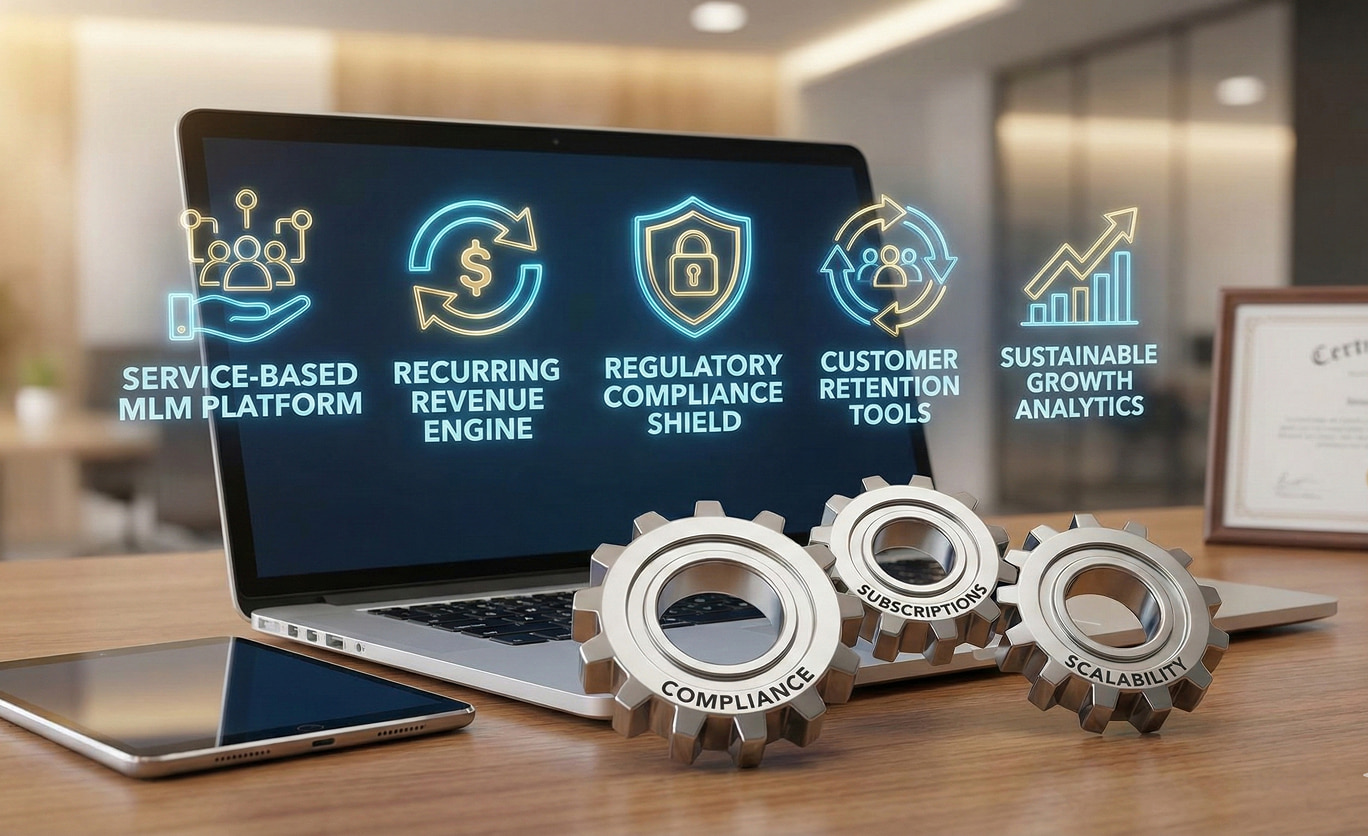Are you confused trying to figure out MLM software pricing? With all the endless features, confusing tiers, and hidden costs lurking around every corner, it’s no wonder you feel overwhelmed. MLM software is the backbone of any successful network marketing operation. Before you commit, you need to understand the true cost of doing business – and the true value you’re getting.
We’re here to help you find a solution that supports your dreams without draining your wallet. In this blog, we’ll break down the key reasons behind the wide price ranges in MLM software, from core technical factors like compensation plan complexity to hidden costs. We’ll also explore how to budget effectively in 2025, and wrap up with a comparison of the top MLM software providers this year.
Did You Know?
According to recent market research, MLM Software Market size was valued at USD 600 Million in 2024 and is projected to reach USD 1,259.12 Million by 2031, growing at a CAGR of 9.97 %. (Source: https://www.verifiedmarketresearch.com)
Why MLM Software Pricing Can Vary Significantly
The cost of MLM software varies widely depending on several critical factors, each influencing the complexity and resources required to provide a tailored solution. Here’s an overview of the main reasons behind these price differences:
Business Model Complexity
Different MLM compensation plans such as Binary, Matrix, Unilevel, or Hybrid require varying levels of backend logic and payout calculation complexity. The more intricate the plan, the more development time and specialized expertise are needed, which brings up costs.
Customization Requirements
The level of MLM customization plays a major role in pricing. Features like a personalized user interface, custom dashboards, multilingual and multi-currency support, as well as integrations with third-party services (e.g., e-wallets and payment gateways) add to the overall expense.
Size of the User Base
The size of your MLM network directly impacts software pricing. Here’s how different user tiers typically affect infrastructure needs and cost:
- 1–500 users: Low cost, basic hosting and reporting.
- 500–5,000: Moderate cost, scalable infrastructure needed.
- 5,000–100,000: High cost, requires advanced performance and analytics.
- 100,000+ usres: Enterprise-level costs, robust cloud infrastructure, and high maintenance.
Deployment Model
Pricing also depends on whether the software is cloud based or on-premise. SaaS (cloud-based) solutions typically have lower upfront costs and offer convenient monthly subscription fees. However, because data is stored offsite, they may pose increased security risks.
On-Premise deployments require a higher initial investment but offer greater control and long-term ownership over the software environment.
Compliance & Security
Meeting strict regulatory requirements such as GDPR, PCI DSS, ISO 27001, and OWASP security standards adds complexity and cost. These standards require additional infrastructure, regular audits, and improved security controls.
Third-Party Integrations
Integrating CRM systems, e-commerce platforms , like Shopify communication tools like SMS or email gateways, and ERP software requires building and maintaining APIs for smooth connectivity, which further increases the cost.
Support & Maintenance
Ongoing expenses such as technical support, software updates, and security patches typically add around 15–20% annually to the total cost of MLM software ownership.
What Increases the Cost of MLM Software? Major Components Explained
When businesses explore MLM software, one of the first things they often ask is: Why does it cost so much? The answer lies in several core components that significantly influence development time, customization effort and infrastructure needs.
Let’s break down the key factors that drive the cost of MLM software.
Whether you’re using Binary, Unilevel, Matrix, Hybrid, or completely custom plans, each model requires a unique logic framework and payout structure. More complex or hybrid plans demand significantly more development time and expertise, especially when businesses need features like an Advanced Compensation Engine.
Require simpler logic and lower development costs.
Need advanced engines and dynamic rules, increasing setup complexity and cost.
Custom payout adjustments by territory or sales volume add development and maintenance expenses.
Managing different plans by product or country demands scalable systems and higher costs.
More complex plans lead to increased ongoing support and upgrade expenses.
Another major cost driver is the level of data intelligence the software offers. Basic reporting might be enough for small organizations, but larger MLMs typically need AI-powered analytics for tasks like churn prediction, identifying top earners, or behavior-based segmentation.
This level of insight helps companies make smarter strategic decisions but requires more sophisticated data modeling and backend systems.
Moreover, the ability to build custom dashboards and KPIs such as drag-and-drop interfaces for sales, compliance, or finance teams adds another layer of complexity.
What was once futuristic is now reality. Build smarter AI-powered MLM with Infinite MLM Software.
Developing a fully branded experience often means building a significant number of custom modules, which increases both time and cost. The more tailored the software is to specific business processes, the more development and design resources are needed.
A white-labeled MLM interface is often essential for companies that want their MLM software to reflect their brand identity. This includes not just the logo and colors but also fully customized dashboards, tailored workflows, and role-specific user views.
Lastly, user volume directly influences your licensing model and system performance needs. A software platform built for thousands of distributors needs more powerful server infrastructure, and the number of administrative roles also affects cost.
Pricing scales with user count – startups may need up to 100 users, while enterprises require thousands.
Larger teams need multiple admin types (Finance, Support, Compliance, IT), requiring role-based access, logging, and reporting.
Systems must handle high traffic during peak times like promotions or payout days.
More users = more transactions, commissions, and reports, demanding stronger infrastructure and higher costs.
Hidden or Unexpected Costs in MLM Software You Should Know About
When investing in MLM software, the upfront price quote is rarely the full story. Many companies discover additional costs after the initial purchase or subscription, which can impact budgets and timelines if not anticipated.
Here are some of the most common hidden or unexpected expenses that MLM businesses should be prepared for:
Customization and Feature Add-ons
While the base software might cover core features, most MLM companies need specific customizations to fit their unique compensation plans, branding, or workflows. These customizations often come at extra cost and can significantly increase development time.
Additionally, if your business evolves and you want to add new features later, such as integrating with a new payment gateway or adding advanced reporting tools, those upgrades can carry steep fees.
Integration with Third-Party Systems
Many MLM platforms don’t operate in isolation. MLM integrations such as payment processors, CRMs, accounting software, ecommerce platforms like Shopify, shipping providers, or marketing tools can incur additional costs, especially if the software vendor charges for API access or custom connector development.
Plus, complex integrations sometimes require ongoing maintenance, adding to long-term expenses.
Interested in learning about the various third-party integrations available for your MLM software?
Scalability and Infrastructure
As your network grows, so does the demand on your MLM software’s infrastructure. Initially, you might start with a small user base, but rapid growth can require upgrading hosting plans, adding servers, or moving to more robust cloud solutions. These scalability-related expenses can catch companies by surprise if they’re not factored into the original budget.
Training and Onboarding
MLM software can be complex, and your distributors and admin teams will likely need training and support to use it effectively. Vendors may charge extra for personalized onboarding, user manuals, or training sessions. Without proper training, adoption slows, reducing ROI and potentially requiring additional support costs.
Support and Maintenance Fees
Many MLM software providers include only basic support in their initial pricing. Premium support options like 24/7 help desks, dedicated account managers, or faster SLA response times often come at a premium. Plus, ongoing software maintenance, bug fixes, and updates may be billed separately or on a subscription basis.
Compliance and Security Upgrades
MLM businesses must adhere to regional laws and data protection regulations (like GDPR or FTC guidelines). Ensuring your software complies can require custom compliance modules or security enhancements, which are not always included in base packages. Staying compliant often means additional investment in legal reviews, audit features, or improved data security protocols.
Data Migration and Legacy System Transition
If you’re switching from an older MLM system, migrating MLM data like distributor info, sales history, and commissions can be complex and costly. Data cleaning, formatting, and validation often require specialized services that add to your project budget.
How to Budget for MLM Software in 2025: A Practical Guide
Investing in MLM software is a critical decision that can significantly impact your business growth and operational efficiency. To make the most of your budget in 2025, it’s important to understand the key cost factors and plan accordingly.
Here’s a step-by-step approach to budgeting for MLM software this year:
Define Your Business Needs Clearly
Start by outlining your MLM compensation plan type. More complex plans will naturally require more development effort and budget. Also, consider your customization needs such as branding, multilingual support, or unique workflows.
Estimate User Base Size and Growth
Determine the current size of your distributor network and forecast growth over the next 2–3 years. Larger user bases need more scalable infrastructure, which affects hosting and maintenance costs.
Decide on Deployment Model
Choose between SaaS (cloud-based) or on-premise solutions. SaaS generally means lower upfront costs with monthly fees, while on-premise requires a higher initial investment but gives you more control and potentially lower long-term costs.
Factor in Integration Requirements
If your MLM software needs to connect with third-party systems like payment gateways, CRM platforms, or marketing tools, budget for integration costs and ongoing maintenance.
Include Compliance and Security Costs
Account for expenses related to compliance with data protection laws (e.g., GDPR) and security certifications, which may require additional infrastructure and periodic audits.
Plan for Support and Maintenance
Software is never truly “done.” Allocate 15–20% of your initial software cost annually for ongoing support, updates, and security patches to keep your system running smoothly.
Prepare for Training and Onboarding
Budget for training your team and distributors on the new system. This may include workshops, tutorials, or hiring dedicated trainers, ensuring faster adoption and fewer user issues.
Get a Live Demo
Before finalizing any budget or contract, request a live demo of the software. Seeing the platform in action helps you better understand its value, usability, and whether it meets both your current and future needs, helping you make smarter budgeting decisions.
Top 5 Leading MLM Software Providers 2025: A Comparison
Here is a comparative overview of the Top 5 Leading MLM Software Providers 2025 to help you choose the right vendor for your business goals.
| Software Provider | Pricing | Compensation Plans Supported | Scalability | Integration Capabilities | Free Demo | Mobile App |
|---|---|---|---|---|---|---|
| Infinite MLM Software | $699 (one-time) | Binary, Unilevel, Matrix, Hybrid, Breakaway Generation, Board, Custom Plans | Enterprise level, all business sizes | Payment gateways, Ecommerce integrations(Shopify) CRM, ERP, e-wallets, API access | Yes | Android & iOS |
| ProMLM iCON | $1,599/month | Supports plans including Binary, Unilevel, Matrix, Custom | Scales for small to enterprise | API, Shopify, WooCommerce, 80+ merchant providers | No | Native app + responsive web |
| ARM MLM | $999 (one-time) | Binary, Unilevel, Matrix, Hybrid | Suitable for small to medium businesses | Payment gateways, CRM integrations, API | Demo Request Needed | Yes, mobile app available |
| ByDesign Technologies | $2,500/month | Compensation plans, incl. Binary, Unilevel, Matrix, Hybrid, Custom | Scales from startups to global enterprises | Shopify integration, CRM sync, e-wallets, APIs across channels | No | Yes, mobile app available |
| Flawless MLM | Contact Vendor | Binary, Unilevel, Matrix, Hybrid | Targets startups to medium enterprises | Payment gateways, API support | No | Yes, mobile app available |
Conclusion: Making the Right Investment in MLM Software
Choosing the right MLM software for your business isn’t just about picking a product with the lowest price tag. It’s about understanding the full range of factors that contribute to the cost, from the complexity of your compensation plans and customization needs to the scalability and support required as your network grows.
The key to budgeting effectively for MLM software in 2025 lies in planning for both the immediate and future needs of your business. By understanding the technical components, hidden costs, and potential scaling challenges, you can make a well-informed decision that aligns with your growth strategy and ensures smooth operation for years to come.
Let’s Build Your MLM Software
– Get Your Custom Quote!
Looking for an enterprise-grade software that meets all your requirements at the most affordable price? Contact us today!
Frequently Asked Questions
MLM software pricing depends on factors like compensation plan complexity, required customizations, size of the user base, deployment model (SaaS or on-premise), integrations, compliance needs, and support requirements. More complex or tailored solutions naturally cost more to develop and maintain.
Hidden costs can include custom feature development, third-party integrations (e.g., CRMs or payment gateways), scalability upgrades, training and onboarding, support fees, compliance enhancements, and data migration from legacy systems.
A good rule of thumb is to allocate 15–20% of the initial software cost annually for support, software updates, security patches, and regular maintenance.
Most platforms support popular plans such as Binary, Unilevel, Matrix, and Hybrid, though some also allow for custom or multi-plan configurations depending on the business model.
SaaS (cloud-based) models offer lower upfront costs and easier maintenance, while on-premise solutions involve a larger initial investment but provide greater control and long-term ownership. The right choice depends on your budget and operational preferences.
As your network grows, you may need to scale up infrastructure, increase server capacity, and support more admin roles. This can lead to higher hosting, licensing, and support costs if not accounted for in your initial budget.
Effective training ensures faster adoption by distributors and admin teams, reducing errors and support requests. Vendors may charge extra for training sessions, documentation, or onboarding services, so it’s important to budget for this upfront.
Leading MLM software providers include Infinite MLM Software, ProMLM iCON, ARM MLM, ByDesign Technologies, and Flawless MLM. Each offers different pricing models, scalability options, and support features so comparing them based on your specific needs is essential.
















